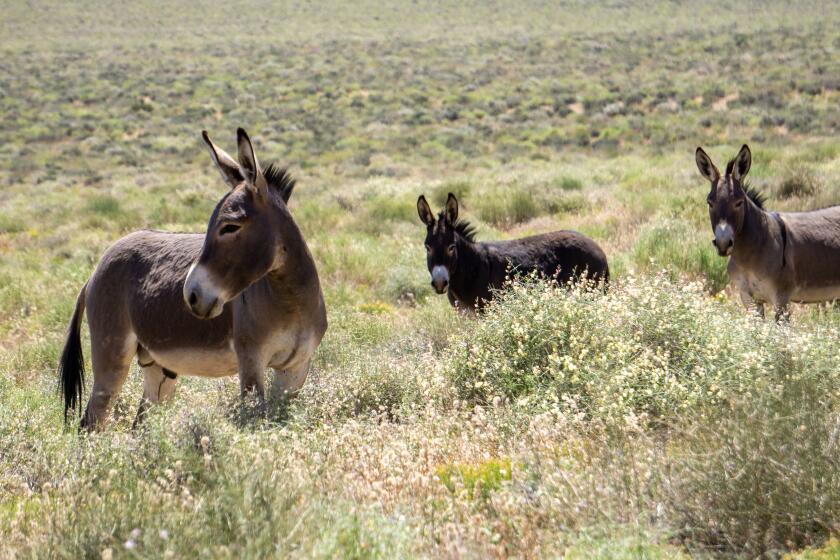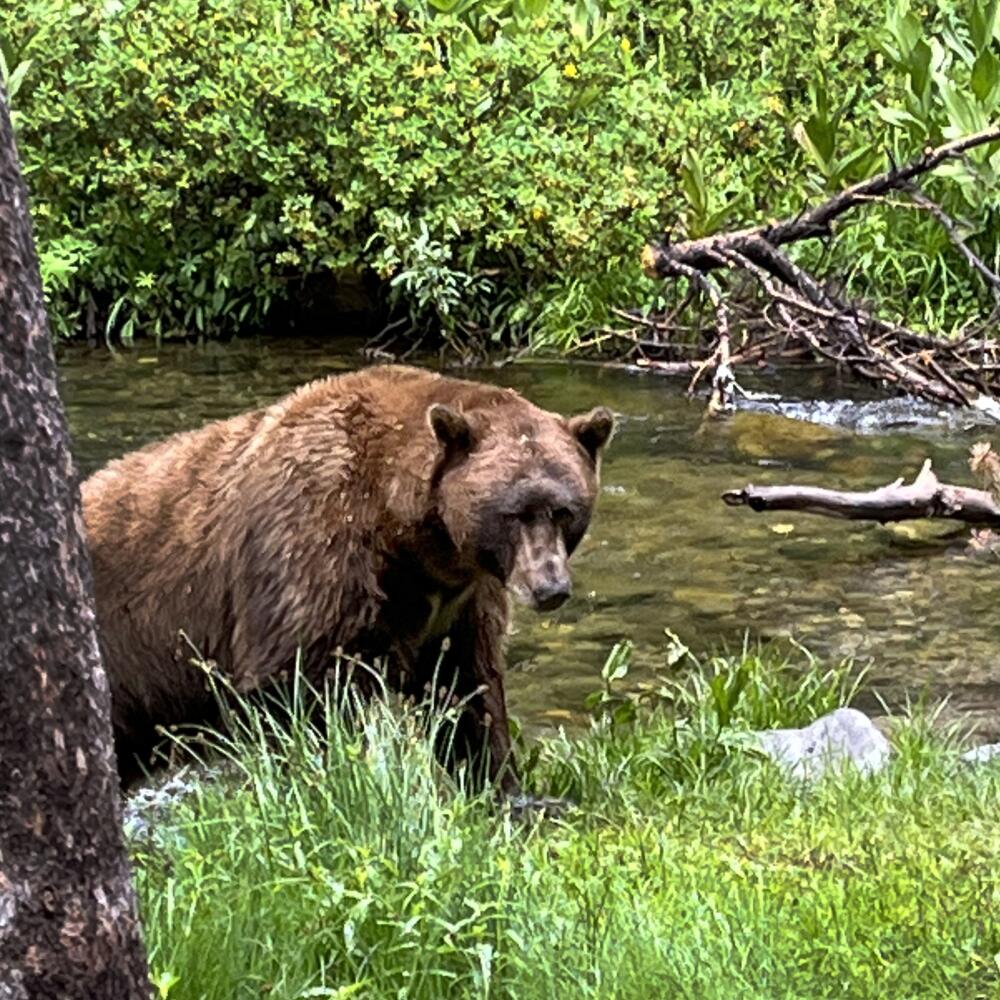
- Share via
A 500-pound bear with chestnut fur and a tan muzzle hunches over a picnic table in a Mammoth Lakes campground, picking over T-bone steak and jostling drinking glasses.
“Don’t spill my wine — that’s all we have!” someone calls out in a video of the incident. Somewhere, out of view of the camera, campers attempt to scare the bear away by making loud clanging noises.
Unfazed by the racket, the hulking mammal then lumbers over to a metal bear box just past a woman who stands looking petrified on a stump.
The woman’s hand shakes as she eyes the beast warily.
The bear then turns to the woman and swipes her leg, sending her fleeing as onlookers gasp. It doesn’t pursue her.
The Aug. 21 video has fueled a raging debate over humanity’s coexistence with wild animals, particularly those that inspire both awe and terror.
(Kathy Spaulding)
For some, the video is an example of people baiting wildlife with perilous consequences. To others, it illustrates the problem of wild animals becoming habituated to interactions with humans.
The quick swipe led to a deep laceration that an eyewitness said went down to the muscle, requiring several stitches. It also prompted a wildlife attack investigation by the California Department of Fish and Wildlife.
An officer was quickly dispatched to interview the 61-year-old woman and collect any DNA the bear may have left on her — then headed to the campsite for additional samples.
The woman told the officer that she believed you should not run from a bear. So when it approached, she clambered up the stump to appear larger and stayed put.
Complicating the situation further, this wasn’t just any bear. Many people in town knew him as “Victor.”
Reports of human-black bear interactions have been on the rise across the country for decades and Mammoth is far from alone in wrestling with how to live alongside ursine neighbors. It’s now believed that about 65,000 black bears roam the Golden State — close to double the estimate from a decade ago.
The incident in Mammoth marked one of four bear attacks the CDFW investigated in less than two weeks, including another attributed to Victor. Last year, a woman’s death in Sierra County marked California’s first fatal black bear attack.
“Black bears are not dangerous animals, but if they associate our homes or cabins or campgrounds as an easy source of food, they lose their natural fear of people and their actions get bolder and bolder,” CDFW spokesperson Peter Tira told The Times in the wake of 71-year-old Patrice Miller’s death in her Downieville home.
In Mammoth, Victor was a well-known fixture in the Eastern Sierra mountain town, often spotted traipsing around scenic lake shores and campgrounds, frequently seizing food or fish. A V-shaped pattern of white and yellow fur adorned his chest — the inspiration for his moniker.
Steve Searles, a former wildlife specialist for the town and “bear whisperer,” who appeared on an Animal Planet show of the same name, said for years Victor ignored the hikers, paddlers and campers drawn to the area.

Victor the bear scratches himself on the side of a bear-proof food locker. (Kathy Spaulding)
But Searles claimed local leaders have slacked off on bear management since he walked away from his post during the pandemic, which he said came in response to them saying he could only work with the bears for half the year and cutting his pay in half. (Town officials declined to comment for the article.)
“It’s just packed with folks that aren’t aware — they’re nice people, they just do dumb ... stuff, and … we’re a tourist town and we’re driven by the dollar,” he said. “It’s been very, very difficult to find a balance.”
An estimated 2.8 million people visit the small town roughly 300 miles north of Los Angeles annually, and the lodging industry generates two-thirds of its gross revenue, according to a town document.
According to Searles, the town is no longer effectively carrying out nonlethal aversion conditioning, “teaching the bears right from wrong,” or punishing tourists for baiting bears.
“So just in a very short period of time, it’s gone sideways” he said.
When considering a course of action following a bear attack, investigators will try to determine whether the bear was baited into acting aggressively. Less than two weeks before the video, Victor caused minor injuries to a man who attempted to take a selfie with the bear. Officers determined that Victor was provoked and took no further action.
But things were different in the videotaped attack. Capt. Patrick Foy, of CDFW’s law enforcement division, said the campers had food out because they were cooking dinner. “It was all perfectly reasonable,” he said. No state wildlife law was broken and no citations were issued.
Because Victor had attacked the woman unprovoked, CDFW now viewed him as a public threat.
The night after beginning their investigation, CDFW staff spotted a large bear at Coldwater Campground.
Kathy Spaulding, camp host, was on duty when she said a wildlife officer showed up around 9:30 p.m. as the bear was chowing down on a big bag of food he had taken from a bear box that was left open.

“And I said, ‘What are you going to do?’ He said, ‘You know what we’re going to do,’” Spaulding told The Times.
Spaulding said she begged the man not to move forward with their plans as he followed the bear’s slow saunter past campsites, paying no mind to people.
“I said, ‘See, he’s not a danger, please, please.’”
Another car pulled up and two men wearing “camo gear” got out, she said.
They shot the animal with a tranquilizer dart. It jumped and dashed across a creek. It weaved, bobbled and stumbled. Then it was still.
At the campground, before the DNA was analyzed, the bear was given a lethal injection. “Unusual but deemed appropriate” because of the high confidence of the match due to his size and markings — including the V on his chest, Foy said. A DNA workup later confirmed it was Victor.
“This bear became too aggressive,” said George Struble, assistant chief for CDFW’s Southern District, adding it had become habituated over time.
“If that was a 6-year-old child that was on that stump, we could be talking about a very different story,” he said at a Mammoth Lakes Town Council meeting in early September. “And that is ... a reality that we weigh when we decide to put down the animal.”
News of Victor’s euthanasia was quickly met with outrage.
Hundreds of online comments have blasted the people in the video and wildlife officials and decried what they see as human shortcomings. Why, some asked, wasn’t Victor moved to another area?
“You invite [Y]ogi to dinner[.] This dude is so lucky he wasn’t de[s]sert. Bad things happen when you play with Mother Nature. Don’t feed our Bears,” one commenter wrote on Facebook.

A Change.org petition calling for “justice” for Victor now has more than 70,000 signatures. It requests fines for “those that began this incident” and for such situations to be handled differently.
“If incidents like this continue to happen, it shows the lack of care for the community that our authorities have and creates a divide in our small town,” the petition reads.
A woman who identified herself as the victim’s daughter described the video through a Spanish translator — which was not taken by her family — as “circulating in a negligent way.”
According to Araceli Contreras, who identified as Indigenous, she and her mother had just returned from a ceremony of “dancing with the bears” when Victor arrived and began picking over their neighbors’ meal.
Once the investigation began, “My mom did tell them that she didn’t want her brother bear to be hurt,” she said via a video appearance at a Mammoth Town Council meeting.
Foy, who said he’s investigated wildlife attacks for roughly 28 years, said the public’s response is a familiar one. “One of the things that I have found in every single investigation, when it gets to the media, is victim blaming,” he said.
The department has also said that relocation is rarely an option for aggressive bears.
“When a bear is causing problems in one area, especially when the bear causes injury to a human, it is uncommon for CDFW to relocate the bear to another area,” the department said in a release. “California is home to 39 million people. There is no longer such place as the ‘middle of nowhere.’”
One of the aspects of Victor’s death that has exacerbated the anguish among his fans was the manner in which his body was handled.
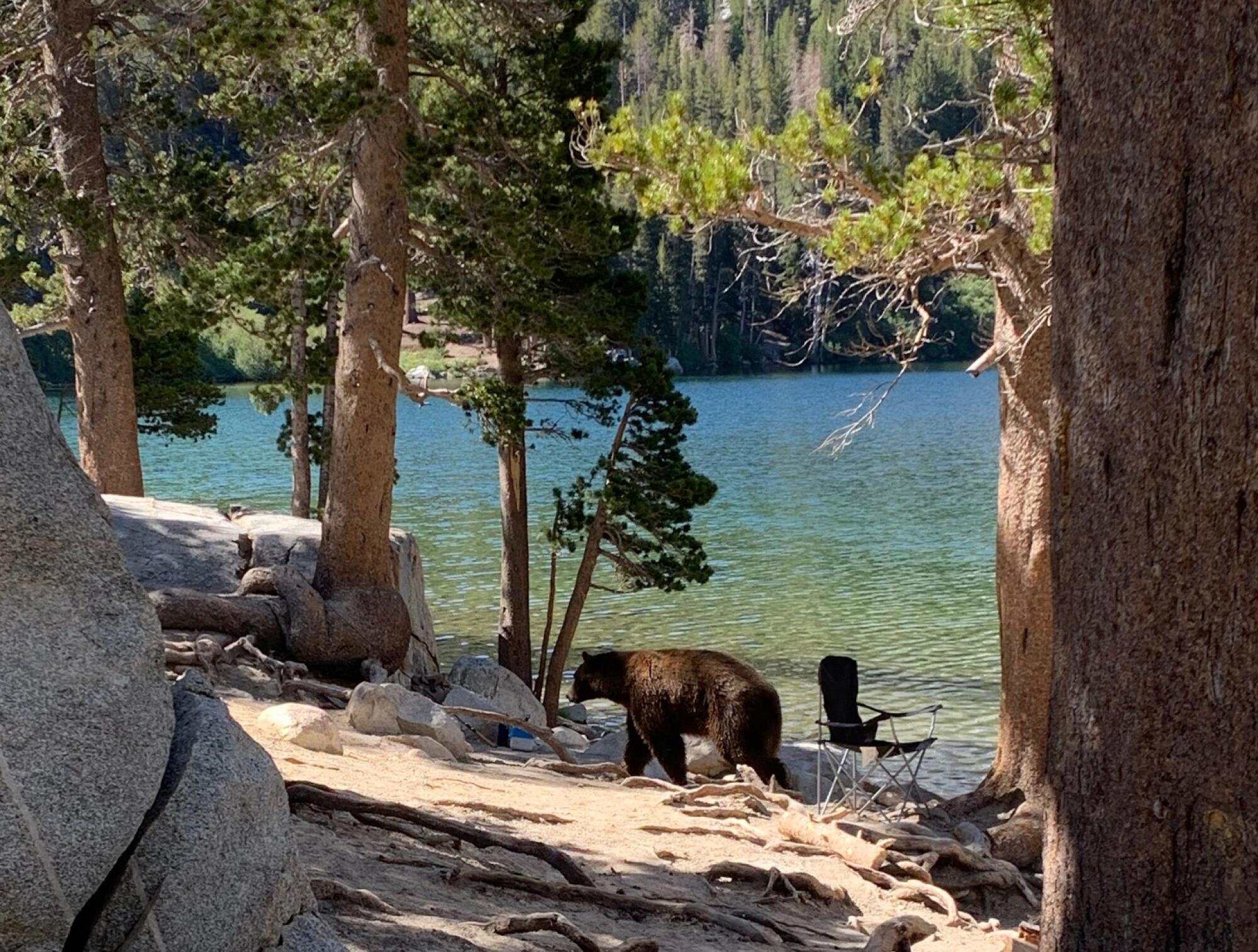
Victor’s body was taken to the Bishop landfill, where people arrived to snap photos as it was being buried, Foy said. At least one of the photos of the deceased bear was posted online, fueling more outrage.
With the cocktail of lethal drugs and tranquilizers in its system, Foy said, the carcass couldn’t be left in the forest for scavengers to ingest.
“Trash and people food is what got Victor killed, and ironically, they put him at the landfill, at the dump,” Searles said.
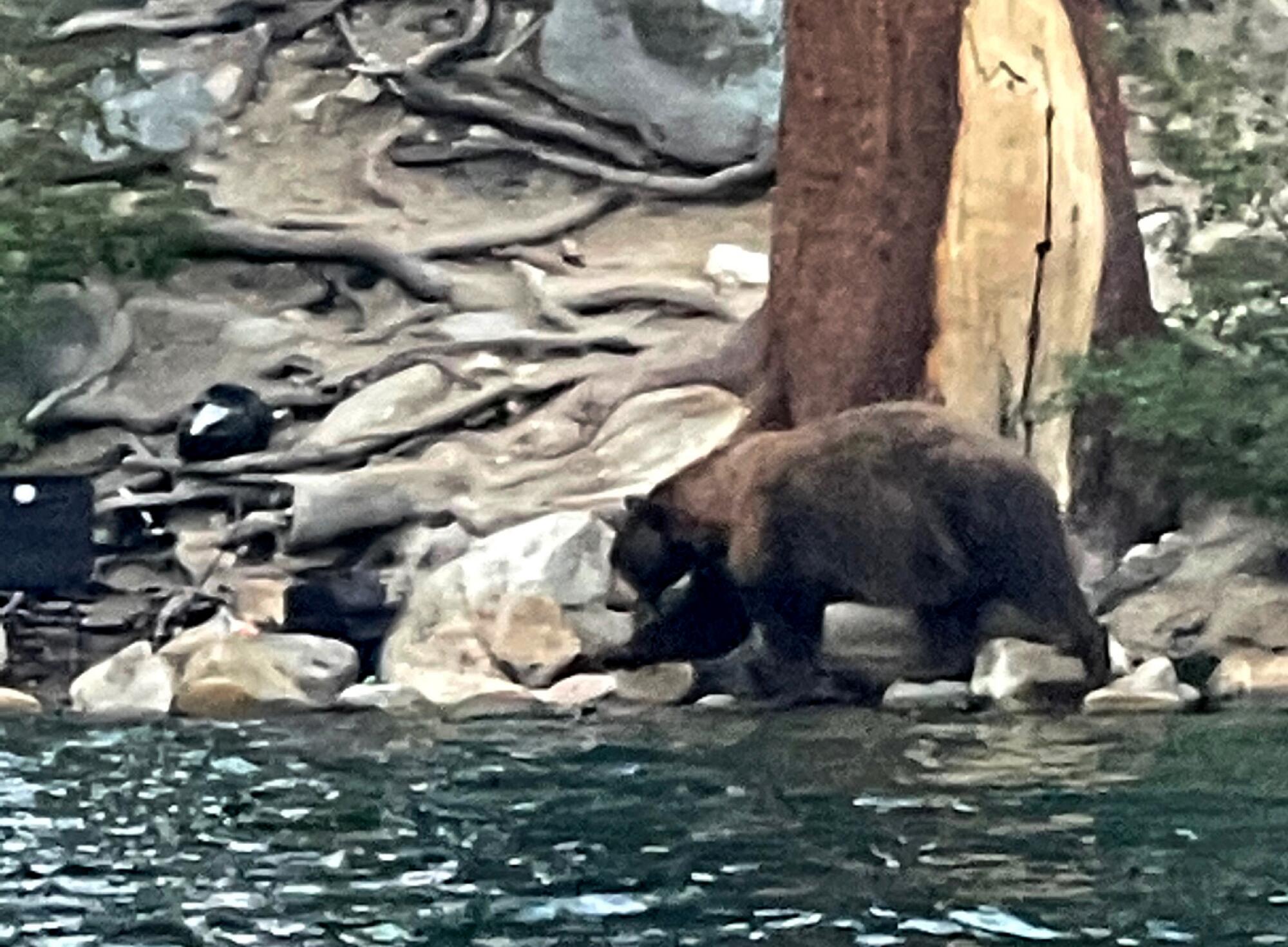
Searles said he and members of the Bishop Paiute Tribe dug up the body several days later and transported it to tribal land for burial and a ceremony that included offerings, songs and prayers.
In a statement, the tribe said it was “grateful for the opportunity to provide Victor with a proper burial, recognizing the Pahabichi [bear] is sacred to their community and acknowledging their role as visitors on Pahabichi homelands.”
Peter Alagona, an environmental studies professor at UC Santa Barbara and founder of the California Grizzly Research Network, said swiping a camper’s leg “is not a natural black bear behavior.” He suggested such incidents are largely preventable.
In a June letter to state wildlife officials, Alagona said the revelation that there are so many more bears in California than previously thought “should be a call to action to increase education, infrastructure investments, community-based programs, tribal co-management and other tools to promote coexistence.”
The letter was sent as a comment on a new draft bear management plan, which officials hope to finalize by the end of the year. None of his suggestions appear “with any apparent clarity or urgency” in the plan, Alagona wrote.
Russell Black, an environmental program manager for CDFW, said he shared in the frustration over the Mammoth incident. With just a handful of staffers handling bear issues across Inyo and Mono counties, he relies on reports made to the department — which he said they never received for Victor.
If they had known, he said they would have taken action long ago.
“There’s a lot that could have been done better early on,” he said.
Searles said he’d been acquainted with Victor for about seven years. He knew where he slept and and would often visit him at the lakes Victor frequented.
“Just to blow off steam, I ride my e-bike up there and hang out with Victor,” said Searles. Unlike other bears, who preferred to exist in the shadows, “Victor worked days,” he said.
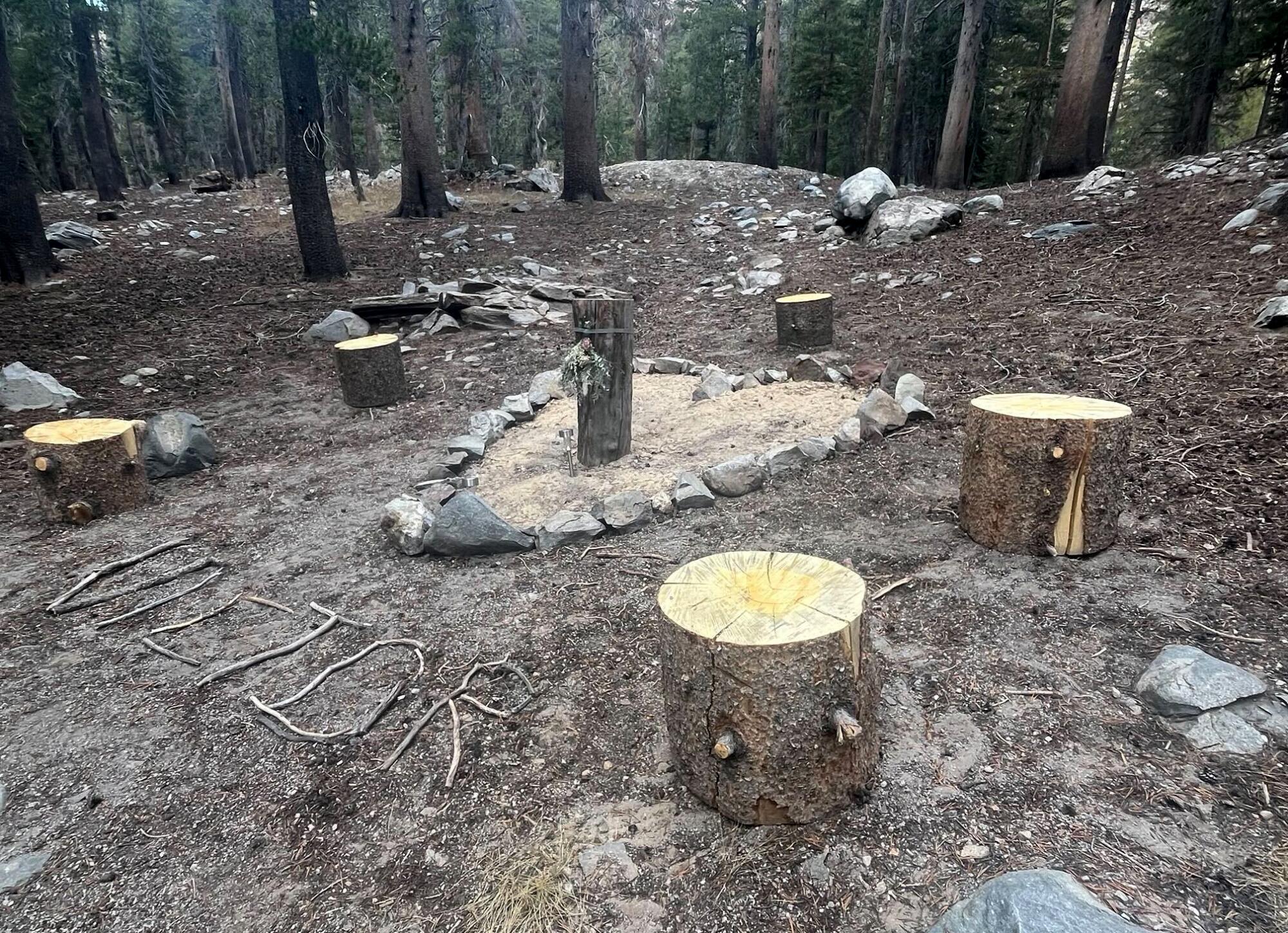
Known for his ursine wisdom — he co-wrote a memoir called “What the Bears Know” — Searles said hundreds of people have reached out with photos and stories of Victor. (Foy, whose email was posted online by the Mammoth Lakes Police Department as the media contact, said he’s received a deluge of hate messages coming from as far away as England.)
While Searles said he understands the community’s pain, and believes tourists do all kinds of ill-advised things, he said he’s not on board with “revenge and hate and fear.” He hopes people can learn from the experience and “do better in the future.”
Working with bears “is just the most magical, wonderful thing,” he said. “It also comes with the lowest of lows, and this is one of those times.”
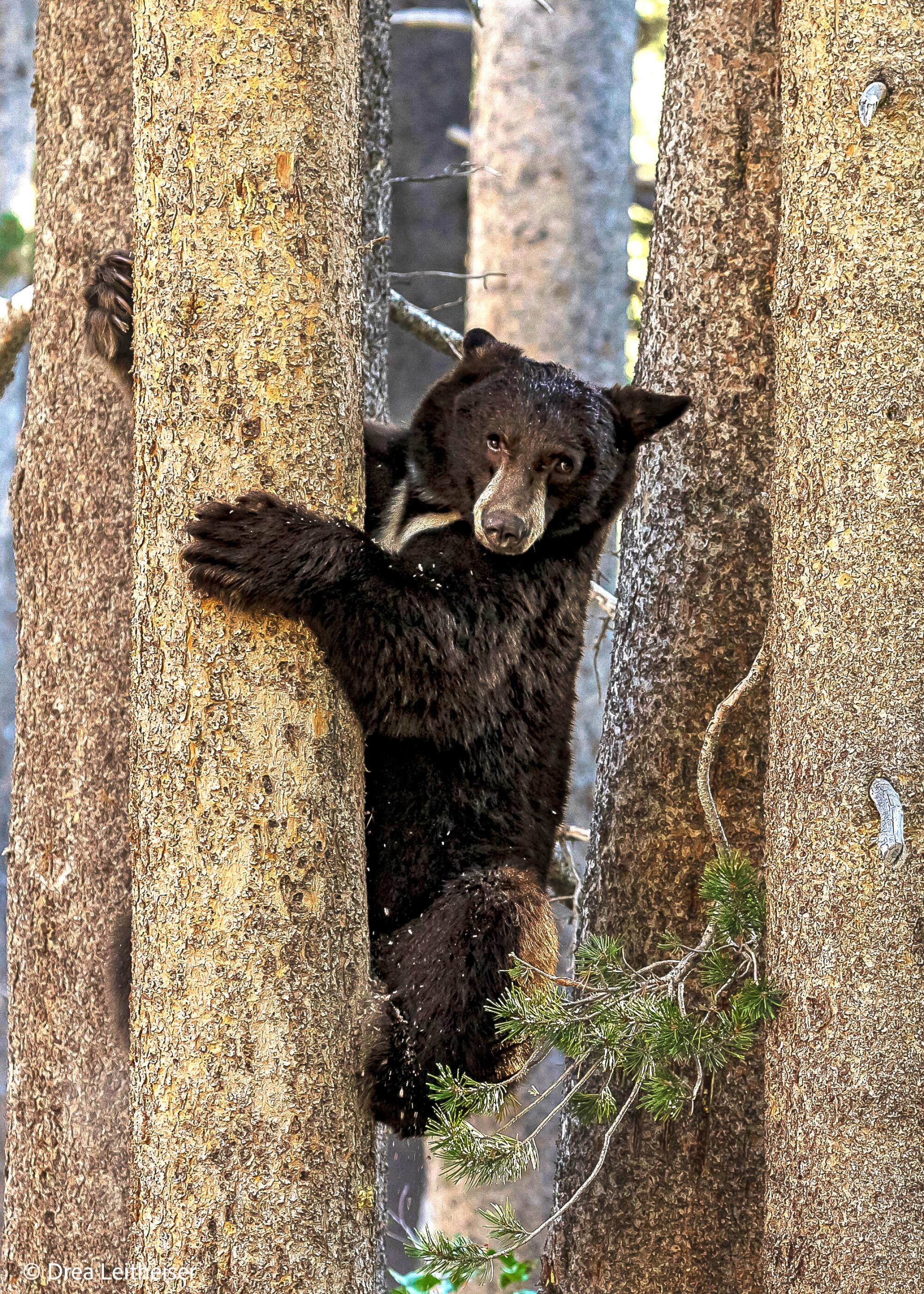
The morning after Victor’s death, camp host Spaulding followed the fresh marks left when officials dragged the body through the dirt.
“I came back, and I told my husband, ‘We have to do something. We have to mark where he took his last time in the — his forest,” she said through tears.
They formed a heart with rocks, planted a log in the center and created a pathway. The makeshift memorial has drawn people who say prayers or share stories about Victor.
Now some fear history might repeat itself with other bears that may move into the vacant territory — including a cub some believe to be Victor’s daughter in part due to a similar V-shaped marking on its chest.
They call her Victoria.
More to Read
Sign up for This Evening's Big Stories
Catch up on the day with the 7 biggest L.A. Times stories in your inbox every weekday evening.
You may occasionally receive promotional content from the Los Angeles Times.









